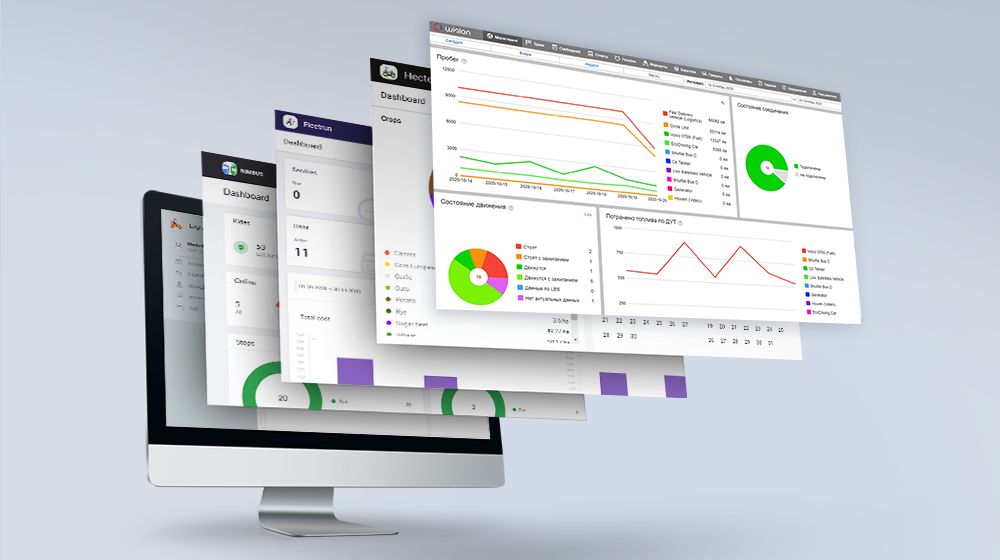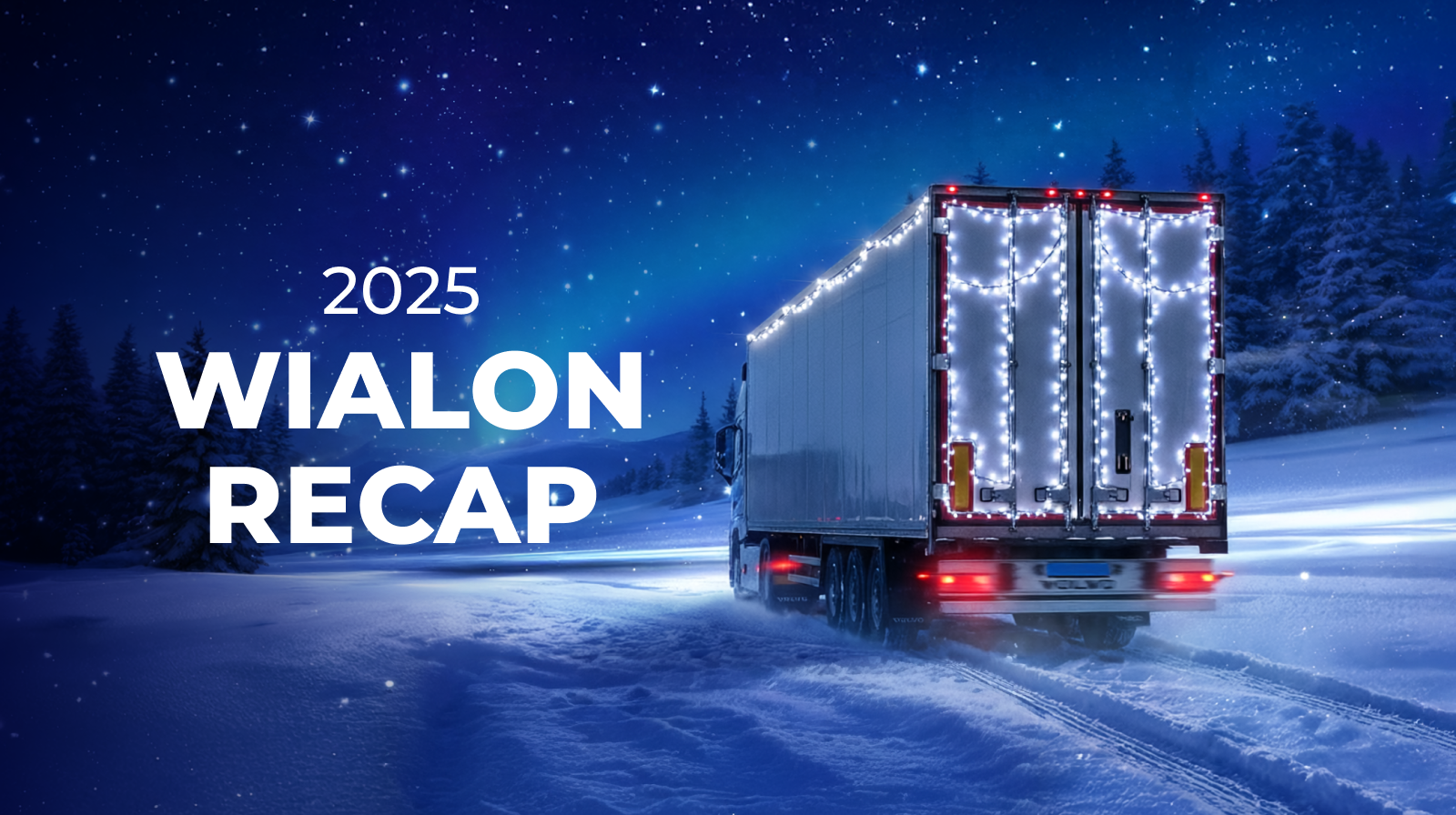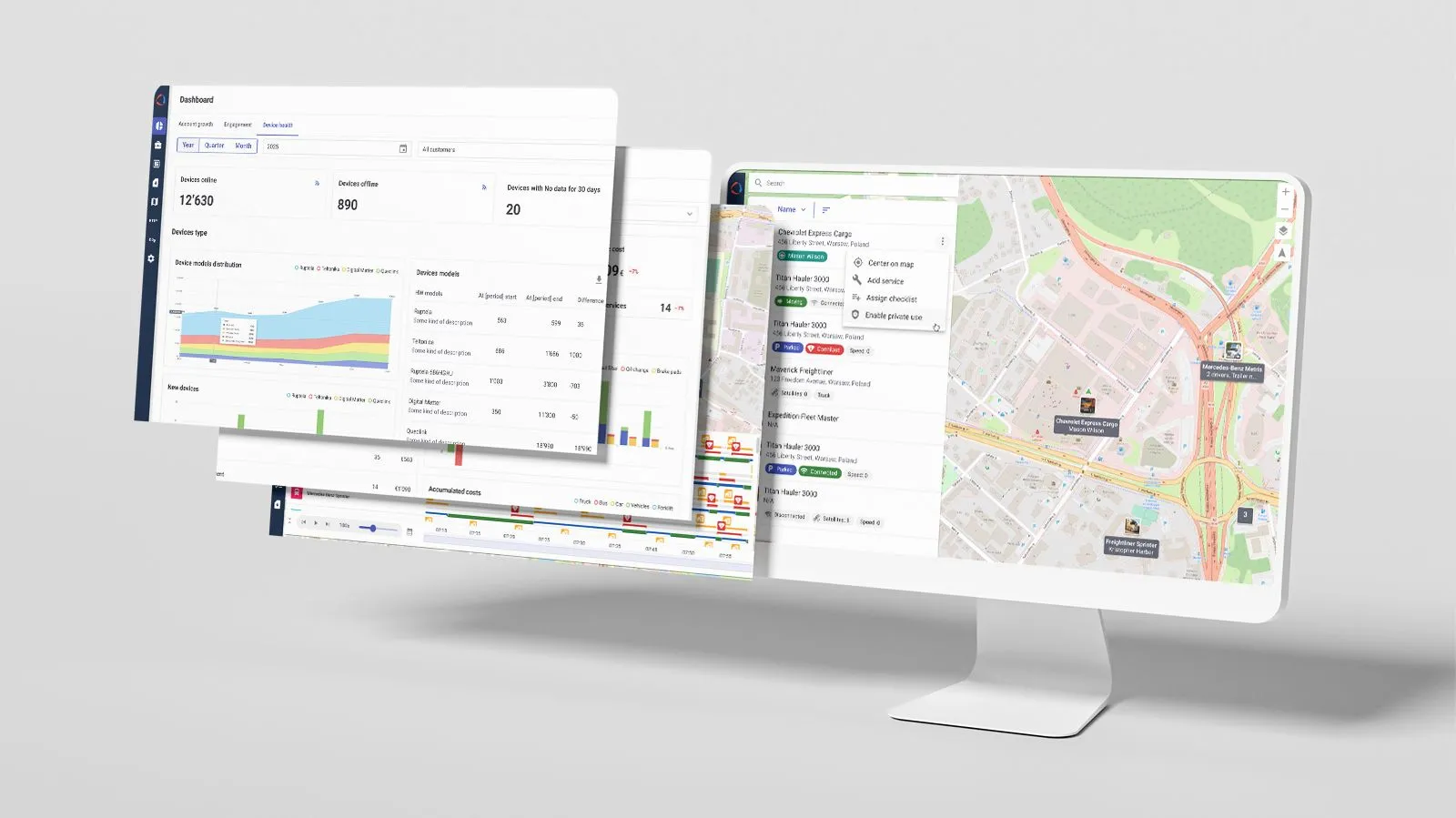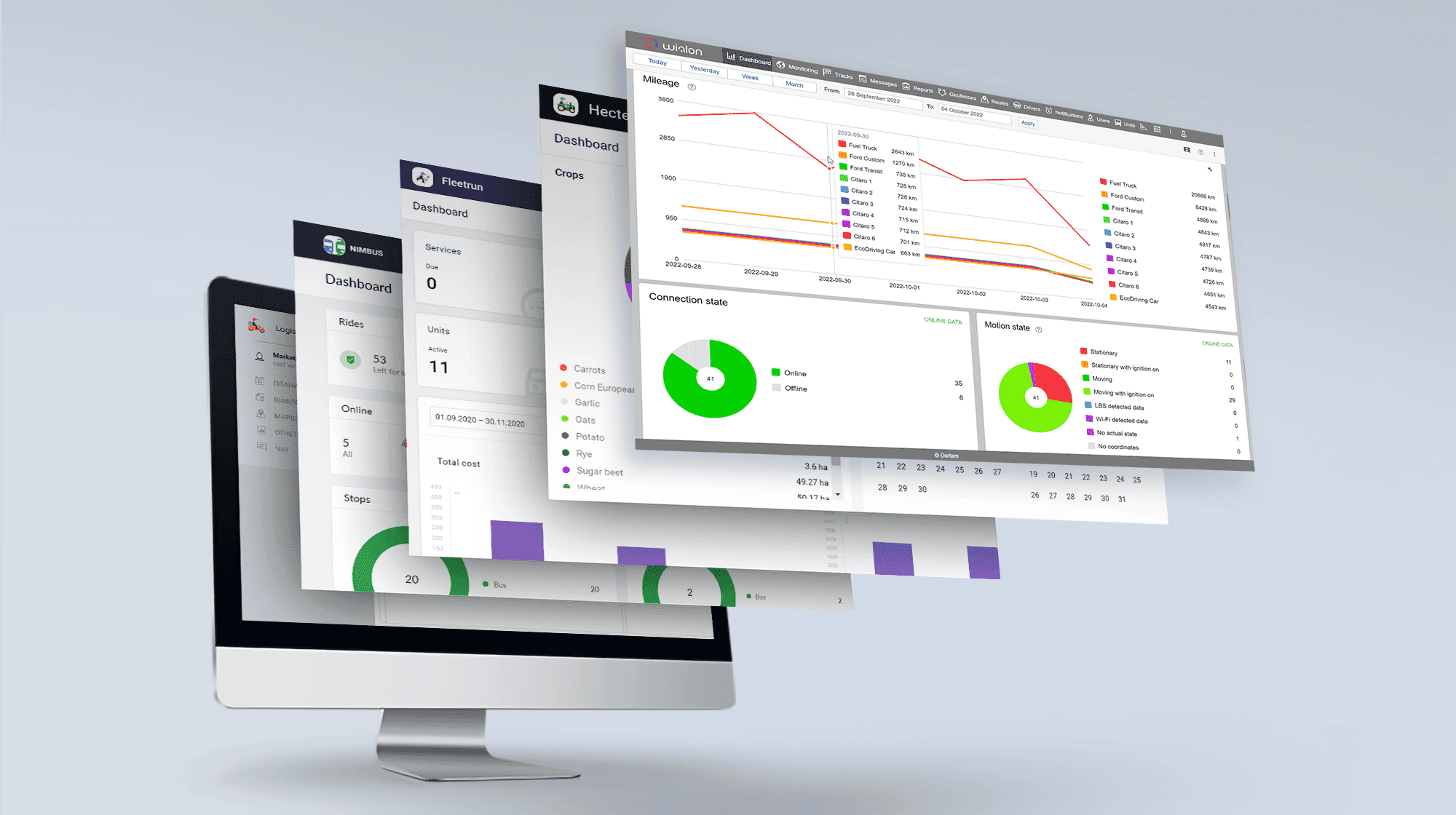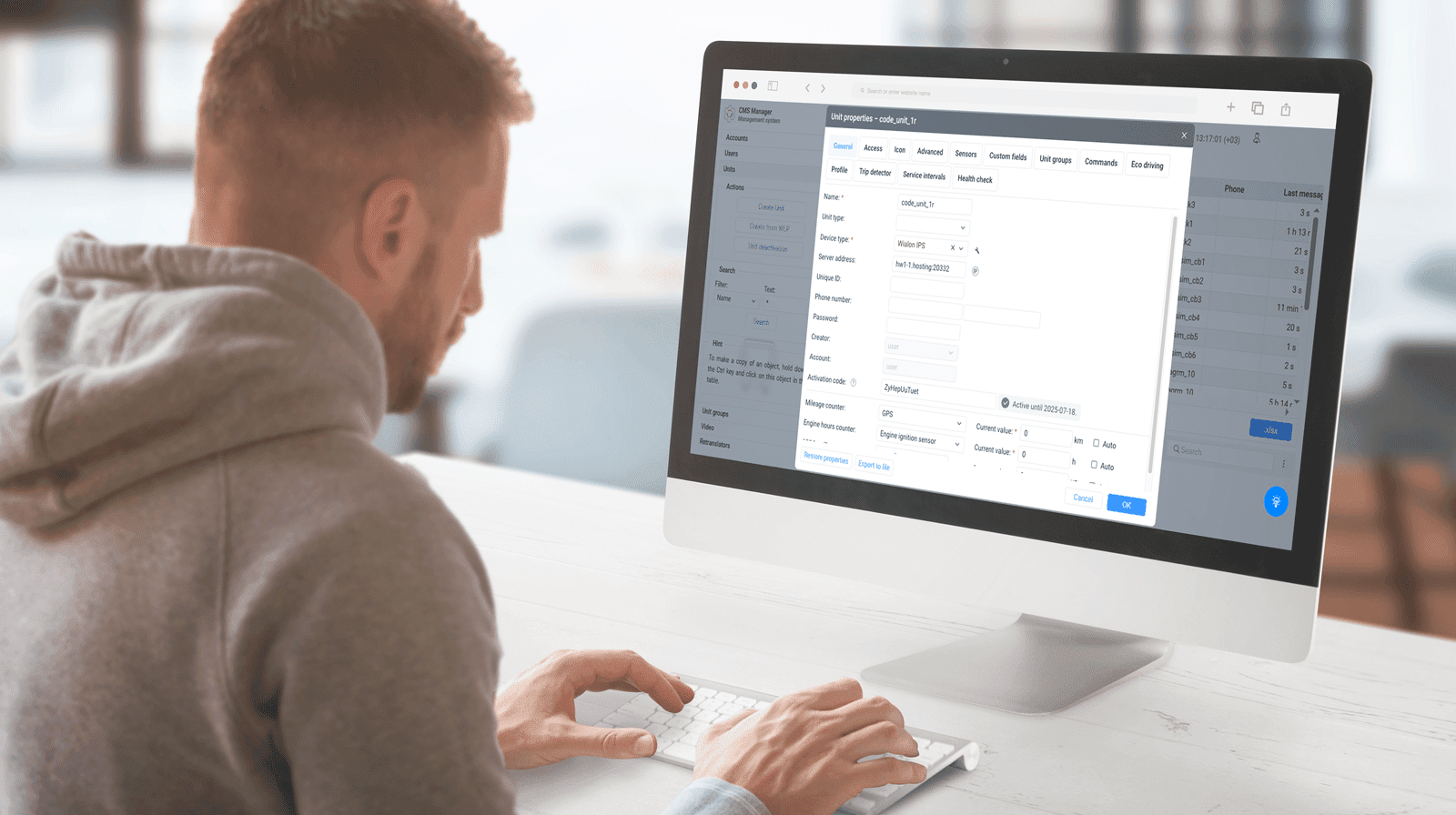We keep improving our monitoring platform and flagship applications. In March, we added the options of Wi-Fi positioning, automatic vehicle type detection, and authorization in Wialon Hosting via third-party apps. Hecterra, Fleetrun, and Logistics were updated as well. Read on to learn the details.
Wialon Hosting
Wi-Fi positioning
When the GPS system cannot determine the unit geolocation, we have added unit coordinates detection with the help of Wi-Fi access points.
How Wi-Fi geolocation works
Now devices that support Wi-Fi-based positioning can send data about the closest Wi-Fi access points to the Wialon platform. The data is used for detecting the unit coordinates.
For this location option, you have to configure certain settings of the system. A user should go to the Advanced properties tab in the Messages validity filtration section, select the Determine location by Wi-Fi points option. Then a user indicates the minimum and maximum amount of Wi-Fi points the signal of which Wialon should receive from the unit. The Accuracy parameter specifies the accuracy of the unit location to be considered valid.
Here is a step-by-step description of how the Wi-Fi geolocation process looks like:
When a device with the enabled Determine location by Wi-Fi points option finds itself between multiple Wi-Fi points, it sends a message with the information about the access points. The purpose of the message is to determine the unit location in relation to the Wi-Fi points.
Wialon determines the coordinates. The system processes the data about the access points, tests them according to the pre-set criteria, and selects the valid ones. Wialon takes the selected points and sends a request to Google Maps to receive the unit coordinates.
Wialon replaces the coordinates in the message. If the data does not meet the established criteria of accuracy, then Wialon leaves the message in its original form.
Turning on the Wi-Fi positioning feature, it's worth keeping in mind its natural limitations. For some operations – for example, a trip calculation – Wialon requires positional data: speed, altitude, satellite info, etc. If you determine the unit location with Wi-Fi coordinates, you cannot take the rest of the data from GPS. Therefore, Wialon won’t be able to determine, let’s say, trips (stops and parking) using Wi-Fi geolocation.
Some types of notifications won't work either, for example, speed notifications. Therefore, Wialon will consider messages with Wi-Fi coordinates only when it is relevant. Primarily it concerns:
- tracks;
- notifications of the Geofence type;
- the columns of reports with addresses and coordinates.
Automatic vehicle type detection
In February, we announced the creation of the unit type library in Wialon Hosting. The idea to launch such a library is to facilitate work with the system for every user.
Now, Wialon can automatically determine the vehicle type. You don’t need to select it yourself – the system will do it for you.
In the future, Wialon will be able to determine other unit types, for example, personal trackers.
In order to teach Wialon to determine vehicle types as accurately as possible, we need to collect as much data from our users as possible. For users with the right to edit the unit properties, we suggest going to the Profile tab and check the vehicle type determined by Wialon.
The more users interact with this parameter (confirm or reject the proposed vehicle type), the more precise the automatic unit type detection will be. We are grateful to all users who are making Wialon better together with us.
Authorization in Wialon Hosting via third-party apps
Previously, a Wialon Hosting user could log into his/her account by using the Wialon login and password. It was quite inconvenient when they used a single corporate account for all their applications and systems except Wialon which required a separate login. In our previous update, we expanded the functionality with the Google login feature.
This time we went further: now a user can log into the Wialon account easier and faster via a third-party app.
Connecting via Auth0
At the current moment, third-party apps gain access to Wialon via the Auth0 provider connected to our platform.
To enable a client to enter Wialon via a third-party app account, first, a Wialon’s partner should connect their application to Auth0. Once it is done, they need to contact our technical support at support@gurtam.com so that we handle the necessary settings on our side. After that, the partner’s clients will manage to link their third-party app account to Wialon and log in to the system’s account much faster.
If you want to use another provider to log in or connect your application directly to Wialon, please contact our technical support at support@gurtam.com.
Linking an account for authorization
Once a user connects his/her application to Auth0, he/she can link the account from this app to Wialon. The process is similar to linking a Google account.
- An additional field appears on the Security tab in the user settings.
- The user enters the third-party app account credentials in the field, thus binding the account to Wialon.
- If connecting the new authorization method is done correctly, a new field appears in the user settings. It contains the email address which will be used now to log in.
The user can easily remove the link to the account with a special button.
The new button on the login page
The new link button with a custom name appears on the login page. The text on the button can be changed, for example, it can be set like: Login with [the app’s name].
This is it for the new system features. Register on the forum and learn about Wialon Hosting updates on a dedicated topic.
Hecterra
Columns with consumables in reports
If there are any registered consumables in the cultivation, they will be displayed not only in the cultivation’s detailed dialog but also in the report table – one column per one consumable. For example, Fertilizers: ammonium nitrate. The display of consumables is turned on by default. You can turn it off in the table’s settings.
Keyboard navigation
To navigate pages and elements on them, we added the ability to use keyboard shortcuts.
| Keys | Actions |
|---|---|
Tab | Move forward |
Tab+Shift | Move back |
Enter, Space | Select an element, click on the button |
Arrow Up/Down | Move forward/back through the list of options; decrease/increase values in numeric fields |
Esc | Close menu |
The new feature will help make usual actions faster and perhaps for some users more convenient.
Freezing the Field column in reports
You can change the visibility of the report’s columns in the table settings. This rule is applicable to all columns excluding the Field column as now it is always visible and can’t be hidden. While scrolling the table horizontally, the user will see that the Field column is fixed. Thus, the user always knows the info on which field he is viewing.
Find more on the new features, as well as comments on the app processing and user experience on the forum.
Fleetrun
Selecting objects and intervals for notifications
Now, when setting up notifications you can select objects or intervals to get notified only on the services created for certain objects or based on certain intervals. All the service objects are selected by default.
Total cost of services and fuel on the unit page
On the Unit info tab on the unit page, you can view not only the service and fuel costs separately but also their total value. To do so, select Total cost in the upper dropdown.
No limit for the number of the List custom field elements
Previously, the user could specify up to 20 elements in the List custom field. In the current update, we removed this limitation. Add as many elements to the list as you need.
It will be useful if your client has a large fleet and needs many custom fields to store necessary information on each vehicle (registration, branding, etc.)
The Czech language
Now Fleetrun is available in Czech.
Find more details on Fleetrun new features in Wialon Help Center. Your requests and suggestions are discussed in the forum topic.
Logistics
Optimization algorithm improvement
The key task of the planning systems is to build the optimal route which means the least costs. To improve the planning efficiency, we developed a new optimization algorithm that improves routing quality. The algorithm allows cutting the delivery costs and at the same time fitting into the delivery interval more often.
Planning modes
We added the ability to choose the planning mode for building the route. You can do it in the Optimization settings and affect the route cost. Three planning modes are available:
- cost-effective (fully loaded vehicles, minimum mileage, loose adherence to delivery intervals);
- balanced (fully loaded vehicles, minimum mileage, strict adherence to delivery intervals);
- fast (reduction in the delivery time due to the maximum number of units).
Planning modes allow customizing the app for the needs of each business. For example, the pizza delivery service will most likely use the fast mode because the clients expect to get their pizzas as fast as possible.
Taking into account the vehicle location
We added the Take into account the location of units option. It helps build routes considering the current vehicle location. If at the moment, the option is enabled, the routes are planned taking into account the location of units at the moment of planning. If the units are fulfilling other routes, then the last points of these routes are taken into account. The location of units can influence the sequence in which the orders are visited, route duration, and mileage.
Application example: if new orders appear during the day, the vehicles are assigned to them taking into account their current location and not the garage location as it can be far which would make a new route not optimal.
Exporting orders
Added the ability to export orders as a table to XLSX and CSV files. The table columns are the same as the order parameters. You can use the files with the orders for import to another account, integration with other systems, and so on.
Visit the forum and read more about the new Logistics options. Please share your experience with the updated functionality.
In a month, we will prepare a recap of April’s features. Meanwhile, feel free to try and test the new features of the platform and apps, as well as leave your comments on the forum. Remember that we make almost all decisions based on your comments.
